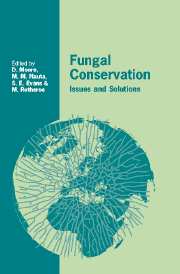Book contents
- Frontmatter
- Contents
- List of contributors
- Preface
- 1 Fungal conservation issues: recognising the problem, finding solutions
- 2 Current trends and perspectives for the global conservation of fungi
- 3 Conservation and management of forest fungi in the Pacific Northwestern United States: an integrated ecosystem approach
- 4 The future of fungi in Europe: threats, conservation and management
- 5 Fungi as indicators of primeval and old-growth forests deserving protection
- 6 Recognising and managing mycologically valuable sites in The Netherlands
- 7 Threats to hypogeous fungi
- 8 Wild mushrooms and rural economies
- 9 Threats to biodiversity caused by traditional mushroom cultivation technology in China
- 10 A preliminary survey of waxcap grassland indicator species in South Wales
- 11 Grasslands in the coastal dunes: the effect of nature management on the mycota
- 12 The conservation of fungi on reserves managed by the Royal Society for the Protection of Birds (RSPB)
- 13 Strategies for conservation of fungi in the Madonie Park, North Sicily
- 14 Fungal conservation in Ukraine
- 15 The threatened and near-threatened Aphyllophorales of Finland
- 16 Fungal conservation in Cuba
- 17 Microfungus diversity and the conservation agenda in Kenya
- 18 Fungi and the UK Biodiversity Action Plan: the process explained
- 19 The Scottish Wild Mushroom Forum
- 20 The contribution of national mycological societies: establishing a British Mycological Society policy
- 21 The contribution of national mycological societies: the Dutch Mycological Society and its Committee for Fungi and Nature Conservation
- 22 Fungal conservation in the 21st century: optimism and pessimism for the future
- Index
14 - Fungal conservation in Ukraine
Published online by Cambridge University Press: 13 October 2009
- Frontmatter
- Contents
- List of contributors
- Preface
- 1 Fungal conservation issues: recognising the problem, finding solutions
- 2 Current trends and perspectives for the global conservation of fungi
- 3 Conservation and management of forest fungi in the Pacific Northwestern United States: an integrated ecosystem approach
- 4 The future of fungi in Europe: threats, conservation and management
- 5 Fungi as indicators of primeval and old-growth forests deserving protection
- 6 Recognising and managing mycologically valuable sites in The Netherlands
- 7 Threats to hypogeous fungi
- 8 Wild mushrooms and rural economies
- 9 Threats to biodiversity caused by traditional mushroom cultivation technology in China
- 10 A preliminary survey of waxcap grassland indicator species in South Wales
- 11 Grasslands in the coastal dunes: the effect of nature management on the mycota
- 12 The conservation of fungi on reserves managed by the Royal Society for the Protection of Birds (RSPB)
- 13 Strategies for conservation of fungi in the Madonie Park, North Sicily
- 14 Fungal conservation in Ukraine
- 15 The threatened and near-threatened Aphyllophorales of Finland
- 16 Fungal conservation in Cuba
- 17 Microfungus diversity and the conservation agenda in Kenya
- 18 Fungi and the UK Biodiversity Action Plan: the process explained
- 19 The Scottish Wild Mushroom Forum
- 20 The contribution of national mycological societies: establishing a British Mycological Society policy
- 21 The contribution of national mycological societies: the Dutch Mycological Society and its Committee for Fungi and Nature Conservation
- 22 Fungal conservation in the 21st century: optimism and pessimism for the future
- Index
Summary
Introduction
In countries that made up the former Soviet Union, however much one wants to concentrate on fungal conservation, general infrastructure problems demand attention. Until they have been addressed, little conservation of anything can take place. Ukraine is no exception. A number of agencies are committed to eliminating poverty and sustaining development in the transition countries in Central and Eastern Europe; the Department for International Development (DFID) is the British government department responsible for this. DFID has published a concise assessment of Ukraine's political, economic and environmental background which can be found in the UK Government's 1998 country strategy paper for Ukraine at the web site <http://www.dfid.gov.uk/public/what/pdf/ukraine_csp.pdf>, with the UK Government's environmental strategy for Ukraine being on <http://bc.kiev.ua/english/work/envstr.pdf>. The realities described in these two straight-talking documents make one admire all the more the dedication of those Ukrainian mycologists who have stayed in Ukraine and who somehow manage to continue their work in surroundings that are often difficult. Problems in Ukrainian science and education are a microcosm of those at national level. The issues that must be faced in solving those problems are extremely difficult, and many are contentious. It is inappropriate to discuss them here.
Ukraine does, however, have a national policy on nature conservation. The present work describes efforts by a team of Ukrainian and British scientists to provide infrastructure for fungal conservation within that national policy, through improved computing and informational resources.
- Type
- Chapter
- Information
- Fungal ConservationIssues and Solutions, pp. 162 - 176Publisher: Cambridge University PressPrint publication year: 2001



